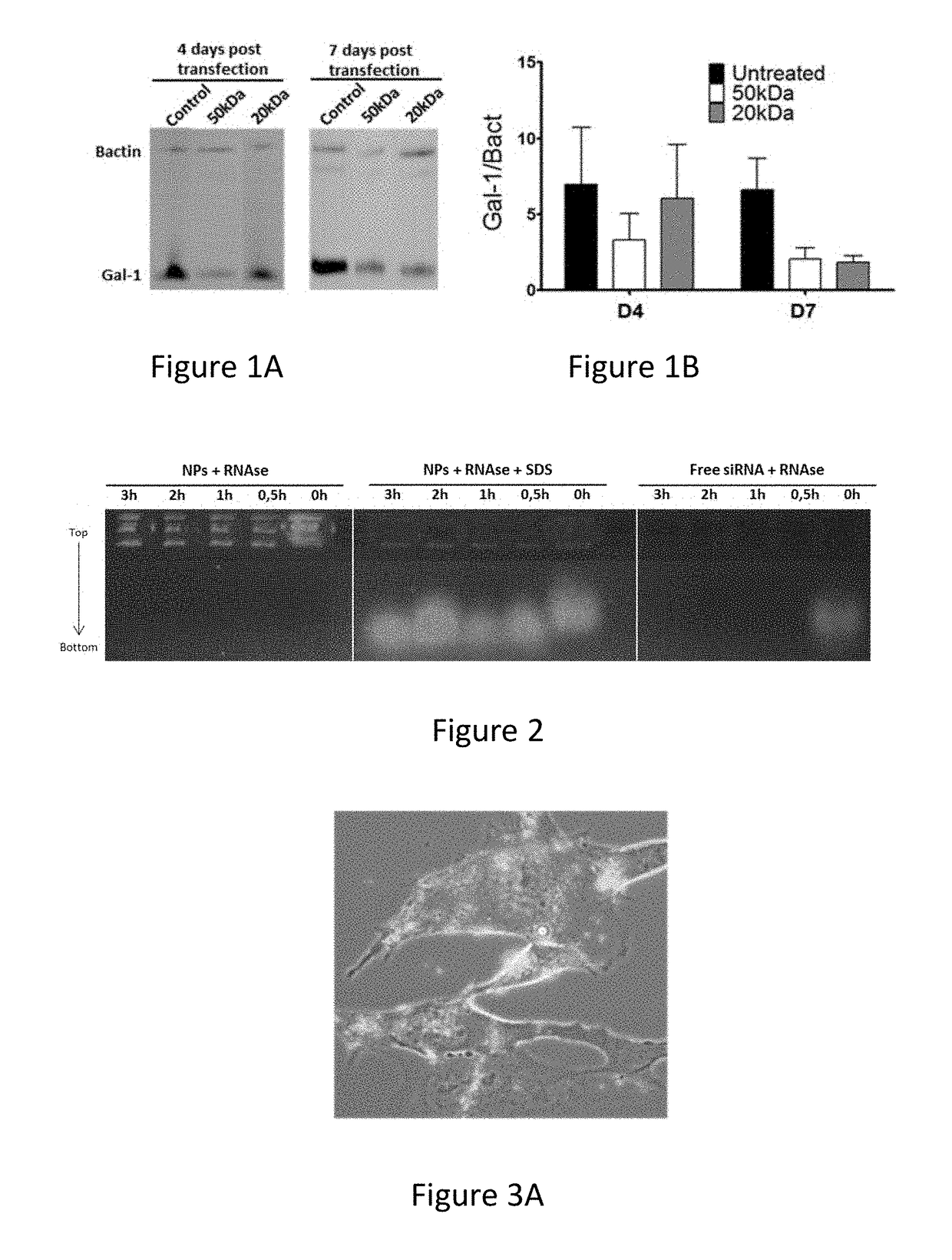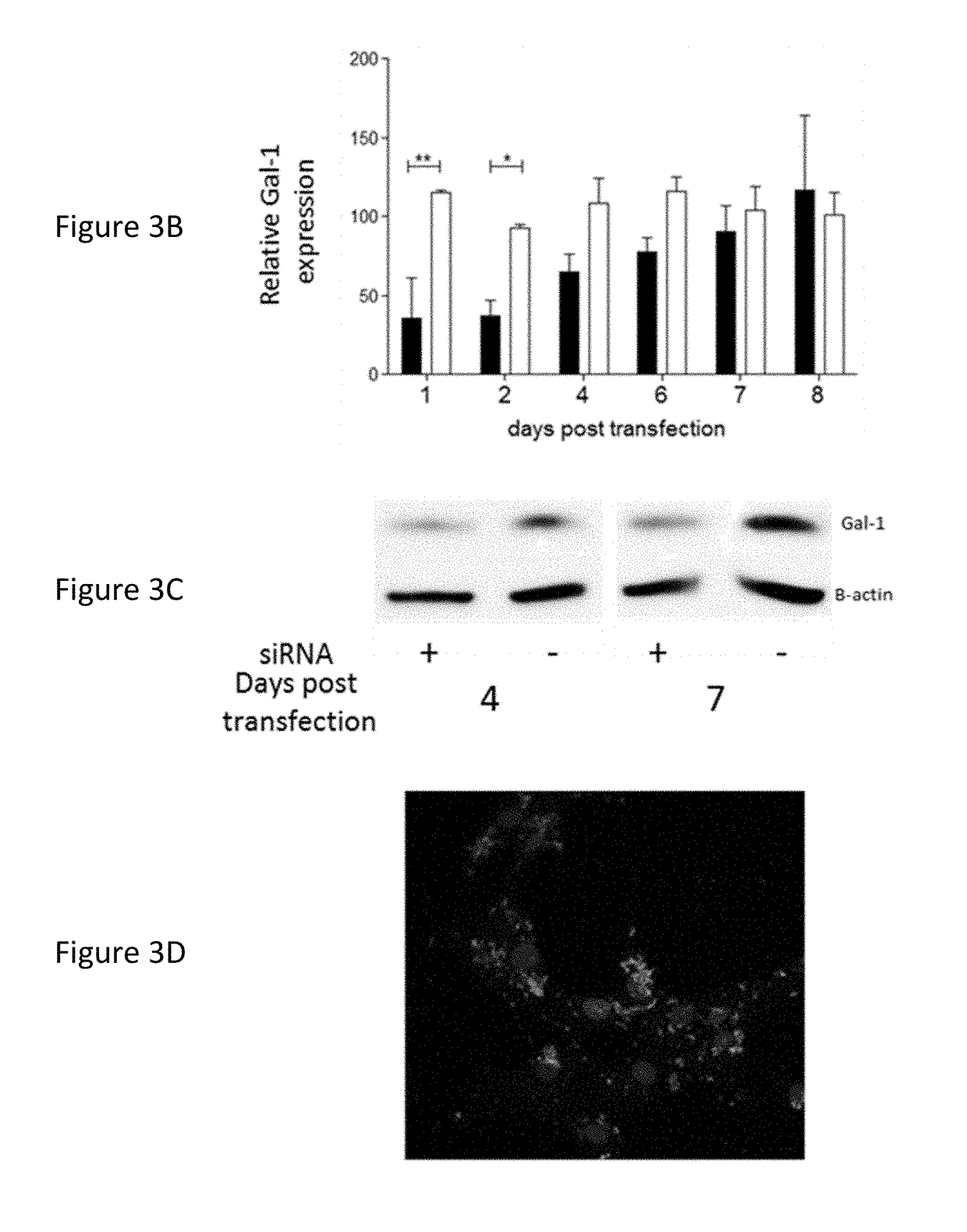Treatment of central nervous tumours
a central nervous system and tumour technology, applied in the direction of capsule delivery, microcapsules, drug compositions, etc., can solve the problems of inability to rescue gbm patients, few have reached clinical efficacy, and inability to achieve clinical efficacy, so as to achieve effective delivery route and reduce the expression of gal-1
- Summary
- Abstract
- Description
- Claims
- Application Information
AI Technical Summary
Benefits of technology
Problems solved by technology
Method used
Image
Examples
example 1
Particle Characterization
[0110]For selection of the optimal formulation, a thorough assessment process was prepared for several parameters of paramount importance. A first selection criterion was the size of the nanoparticles. Therefore, we assessed the influence of the molecular weight of the chitosan polymer, the concentration of chitosan, and the stirring speed on the hydrodynamic size (Z-average) of the nanoparticles (Table 2). Lower molecular weight, higher stirring speed, and lower concentration of chitosan resulted in the smallest particles with an average size of 147 nm and poly-dispersity index of 0.27 (Table 3). Further dilution of chitosan (<0.7 mg / ml) did not result in formation of particles (data not shown). Zeta-potential was not influenced by these parameters and was determined to be +32 mV. For further work, the smallest nanoparticles were selected; manufactured with 50 kDa chitosan, stirred at 1300 RPM, and dissolved at 0.7 mg / ml. After production, the particles wer...
example 2
siRNA Encapsulation and Protection from Degradation
[0116]The siRNA carrier capacity of chitosan nanoparticles was evaluated by using SYBR green assay. To avoid loss of siRNA, a maximal loading capacity of 24 μg / ml siRNA was chosen for further studies: we observed that in that condition, 81% of siRNA was encapsulated into the nanoparticles. The formulated siRNA was instantaneous released upon incubation with 0.1% SDS, as indicated by a sudden loss of encapsulation efficiency (Table 3). Moreover, we also confirmed the high encapsulation efficiency via the ultracentrifugation concentration process. After three centrifugal cycles, we measured that 85% of the fluorescent siRNA is inside the pellet (data not shown).
[0117]Furthermore, the siRNA protection from degradation was evaluated with a degradation assay (FIG. 2). No degradation of siRNA was observed when the siRNA-loaded nanoparticles were incubated with RNases at 37° C. for several time periods. For better visualization, particles ...
example 3
Nanoparticles Behaviour on Tumoural Cells
[0120]Attachment of the formulation was tested on both a murine GBM cell line, GL261, as well as on human primary GBM cultures. In both cases, 2 h after co-incubation in serum free media, a rapid attachment on the tumoural cells was observed (FIG. 3 A+D). To evaluate if the attachment of the particles on the GL261 tumour cells also induced a suppression of Gal-1, mRNA and protein analysis was performed (FIG. 3 B+C). For the GL261 cells, a strong and specific Gal-1 mRNA degradation was observed rapidly after transfection. After 1 week, the Gal-1 mRNA was recuperated. On protein level, a strong decrease was observed starting from day 4 after transfection until at least day 7. In parallel, the Gal-1 degradation of primary cultures was analysed (FIG. 3 E+F). In six independent primary GBM cultures, a strong decrease was notable from day 4 to day 7 post transfection.
[0121]To further investigate the biological significance of Gal-1 suppression, an ...
PUM
| Property | Measurement | Unit |
|---|---|---|
| Fraction | aaaaa | aaaaa |
| Mass | aaaaa | aaaaa |
| Mass | aaaaa | aaaaa |
Abstract
Description
Claims
Application Information
 Login to View More
Login to View More - R&D
- Intellectual Property
- Life Sciences
- Materials
- Tech Scout
- Unparalleled Data Quality
- Higher Quality Content
- 60% Fewer Hallucinations
Browse by: Latest US Patents, China's latest patents, Technical Efficacy Thesaurus, Application Domain, Technology Topic, Popular Technical Reports.
© 2025 PatSnap. All rights reserved.Legal|Privacy policy|Modern Slavery Act Transparency Statement|Sitemap|About US| Contact US: help@patsnap.com



